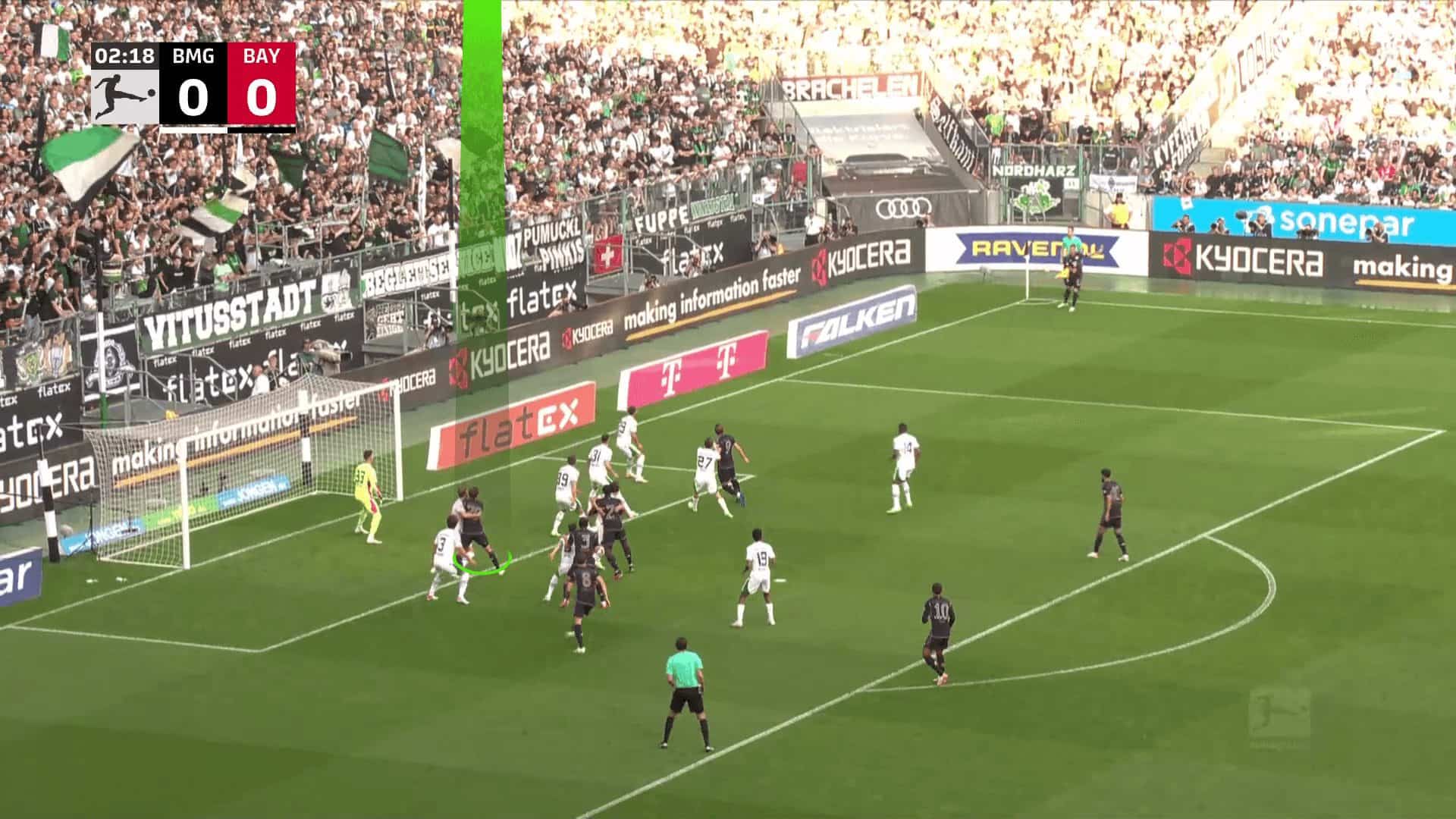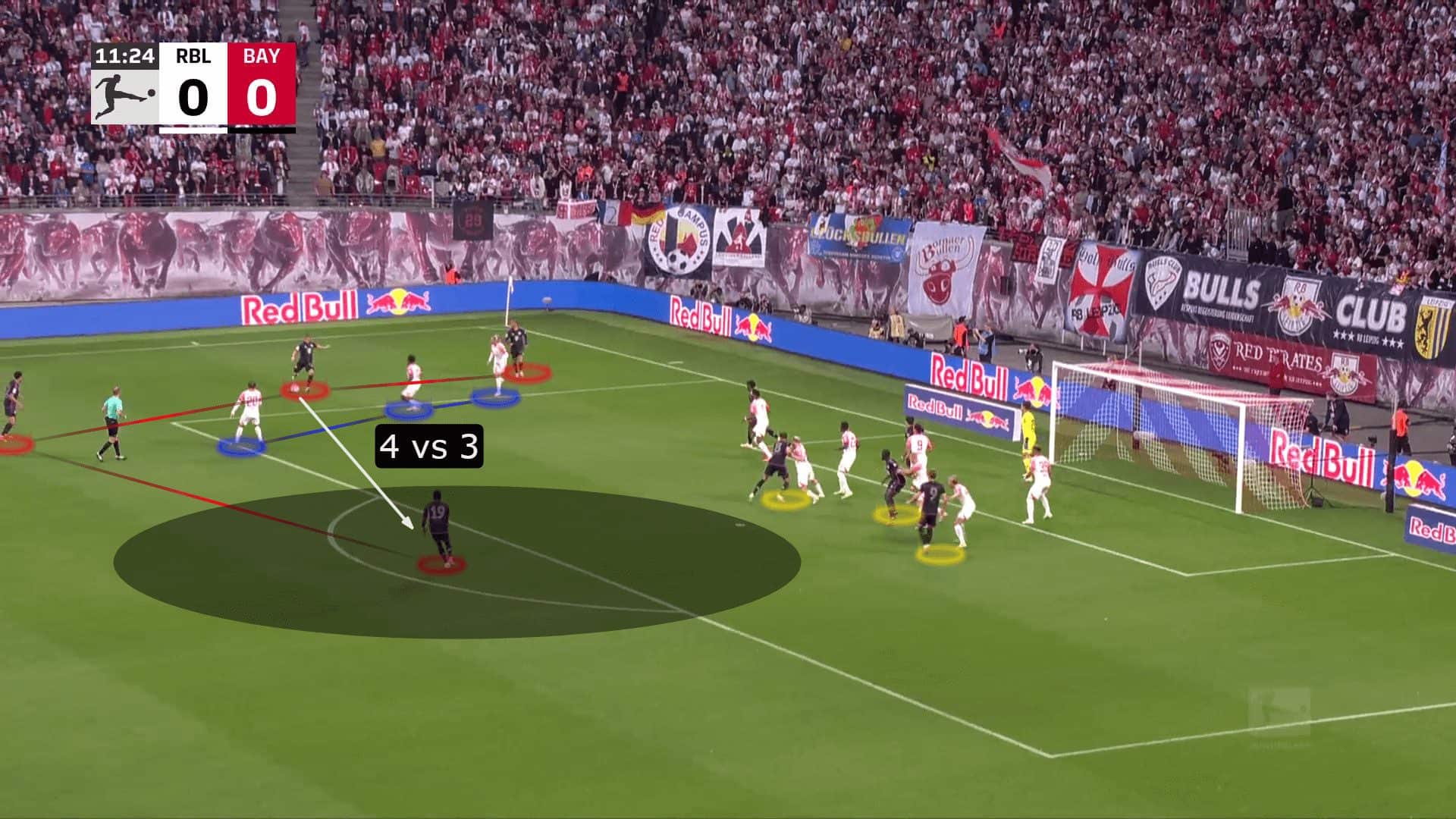Bayern Munich occupies the second place in the Bundesliga with 29 points from 11 matches, two points behind Bayer 04 Leverkusen, the first-place holder. It seems that we will witness fierce competition for the title between FC Bayern and Xabi Alonso’s team, which makes us address a point that may be important and decisive in this struggle, namely set pieces.
Thomas Tuchel’s team occupies the first place as the most team scoring from set pieces in the Bundesliga, tied with Bayer Leverkusen and Borussia Mönchengladbach, but Bayern have the highest xG (6.33) in the Bundesliga, while Borussia Dortmund are in the third place with 5.86. Bayer Leverkusen are in 13th place with 2.71, indicating Bayern Munich has more dangerous and closer chances to the goal.
Bayern Munich also enjoyed the diversity in using set pieces, as they scored five goals in the Bundesliga from corners, the second-scoring team from corners after Borussia Mönchengladbach with six goals, but they also scored two goals from free kicks.
In this tactical analysis, we will discuss the different tactics of Bayern Munich in both corners and free kicks in the Bundesliga, DFB-Pokal and UEFA Champions League.
Free-kicks
Bayern Munich prefer to target the area behind the last player of the defending line by blocking him from another player to free the space for the targeted player who comes from a farther distance with his pace, having the time to target this area while the ball is in the air and this is the reason for targeting the far post in these routines besides being away from the goalkeeper who can’t go to pick the ball, as we will show in the following case.
In the first photo, our two targeted players are highlighted in red coming late, not offside, with their pace with the aid of the two blocks, highlighted in green in the second photo, from the two players who are in offside positions to block the two defenders from their back preventing them from dropping with the line to empty the path of our two targeted players.
In the third photo, our two targeted players are free, but why two? The first targeted player is in a far area after the far post, so he can’t score from the first touch, but he can nod the ball by his head to the second targeted player, as shown in the fourth photo.

But the cross is a little powerful, so the first targeted player can’t control the headed pass, as shown below.

As mentioned above, they have many diverse ideas because variation is too vital in set-pieces to be unexpected; they have another idea to use the far post as bait to target the near post, as in the next example.
In the first photo, we should focus on three players tracking their movements: Thomas Müller in blue, Harry Kane in red and Kim Min-Jae in green.
In the second photo, Kim Min-Jae moves early before the taker touches the ball to drag the last defender with him to make Müller and Kane not offside on the near post, although they start from offside positions.
In the third photo, the plan works, and Müller gets the ball, but the goalkeeper saves it, as shown in the fourth photo.

We have shown some of their ideas in free-kicks, and now, we offer their different ideas in attacking corners.
Runs from the rebound zone
Thomas Tuchel’s team has a good idea to target players coming late from far areas, from the rebound zone, to be free from man-marking, can measure the ball in the air, predicting where it will land, knowing when to jump and also come from a more free space before jumping to have a dynamic superiority against any defender occupying the targeted area jumping from a steady state, as we will explain in the following case.
In the first photo, we should first know the opponent’s defending system to understand the routine well. They defend by five players in the zonal line: three man-markers, a player for the short-option pass and a zonal player to defend the rebound zone.
In the second photo, our targeted player starts from the rebound zone, aiming to target the area in front of the last zonal defender on the far post, but to make sure that the zonal defender who defends the rebound zone will focus on or follow him, a second attacker stands in the rebound zone very close to him to take the defender’s attention fixing him there afraid of leaving the rebound zone.
In the third photo, an attacker blocks his man marker to make sure that the targeted player’s path is empty so he won’t find any obstacles until he reaches the zonal defender, highlighted in red, whom he will overcome because of the dynamic superiority he has by taking all his path free, so he can run enough before jumping with the aid of two yellow blocks, as shown in the fourth photo.

The plan works, so our targeted player gets the ball, but the headed shot is in the middle of the goal, so the goalkeeper receives it, as shown in the next two photos.


Although the targeted player could get the ball using his dynamic superiority, he can’t control the ball quickly, so we suggest that it could be better if the attacker, highlighted below, blocks the last zonal defender instead of the second one on the line, from the far post because the second defender would cut a longer distance to reach the ball in the targeted area.

Short Corners
One of the most important things they have shown excellence in is using short corners, in which they have used many routines with different tactics. They prefer to have numerical superiority in the short and rebound areas, as we will explain below in detail.
We will start with their idea by achieving numerical superiority with a 2-v-1 situation. In the first photo below, the defending team defends the short option by a player, which sounds good. Still, after passing the ball short, he should be helped by another player, usually the green-highlighted one, to avoid the 2-v-1 situation, which is apparent after the pass in the second photo. Hence, the short-option attacker passes the ball again to the taker in all that empty space shown in the third photo.
But what about the second part of the plan? We should keep tracking the two highlighted attackers in the fourth photo to know that.

As shown below, One of them drops down, pretending that he will receive a cut-back pass, dragging the first defender with him while the second attacker targets this left area.

The plan works, so the attacker gets the ball, and the result is a goal, as shown below in the two following photos.


As we have repeatedly said, they keep using one of the most essential principles in set pieces, variation, so you can note that they create a routine. Opponents get a counter idea, and then they get a solution to get through the counter idea, so if an opponent defends the short and rebound areas with two or more players to avoid the 2-v-1 situation, they have no problem creating a 3-v-2 or even a 4-v-3 situation, as we will explain below.
In the first photo below, The opponent has three defenders to defend this area: one for the short option, a player on the rebound zone and one who stands initially on the near post and then moves to help.
Bayern Munich starts the corner by asking the short-option attacker to be closer to the taker to force the blue-highlighted defender, who comes to help the yellow defender to take more distance in a longer time.
In the second photo, Bayern committed another trigger to make the rebound defender leave his area to help in the short spot, which is having another short-option attacker out of the shot, to make it a 4-v-3 situation.
In the third photo, the 4-v-3 situation is clear, but to make sure that nobody will go to defend the rebound zone, the three yellow-highlighted players block their man markers. Hence, the rebound area is empty for the attacker to receive a direct pass and then shoot, as shown in the fourth photo.

But the shot wasn’t good, so the ball hit a defender, as shown below.

Conclusion
In this analysis, we have explained the strengths of Bayern Munich in set pieces and the diversity of their ideas, whether in free kicks or corners, explaining why they became the most threatening team to the goal by set pieces in the Bundesliga.
In this set-piece analysis, we have explained their targeting of the far post in the free kicks, either as a direct target or as a bait to target the near post without offside. As for the corners, we have explained their use of short corners and their tendency to target players coming from the rebound zone.






Comments